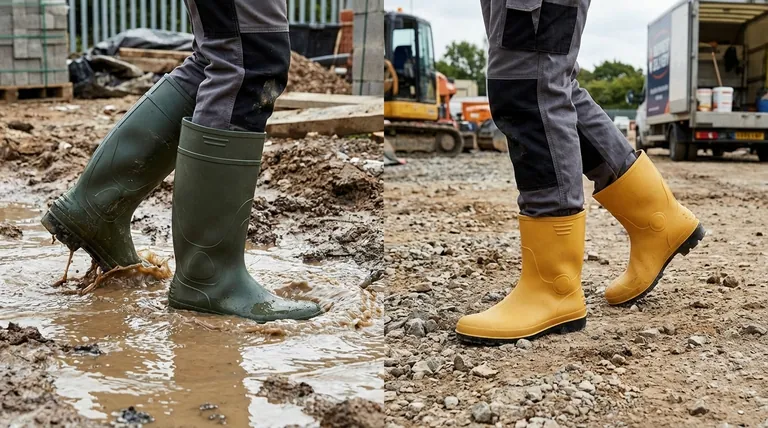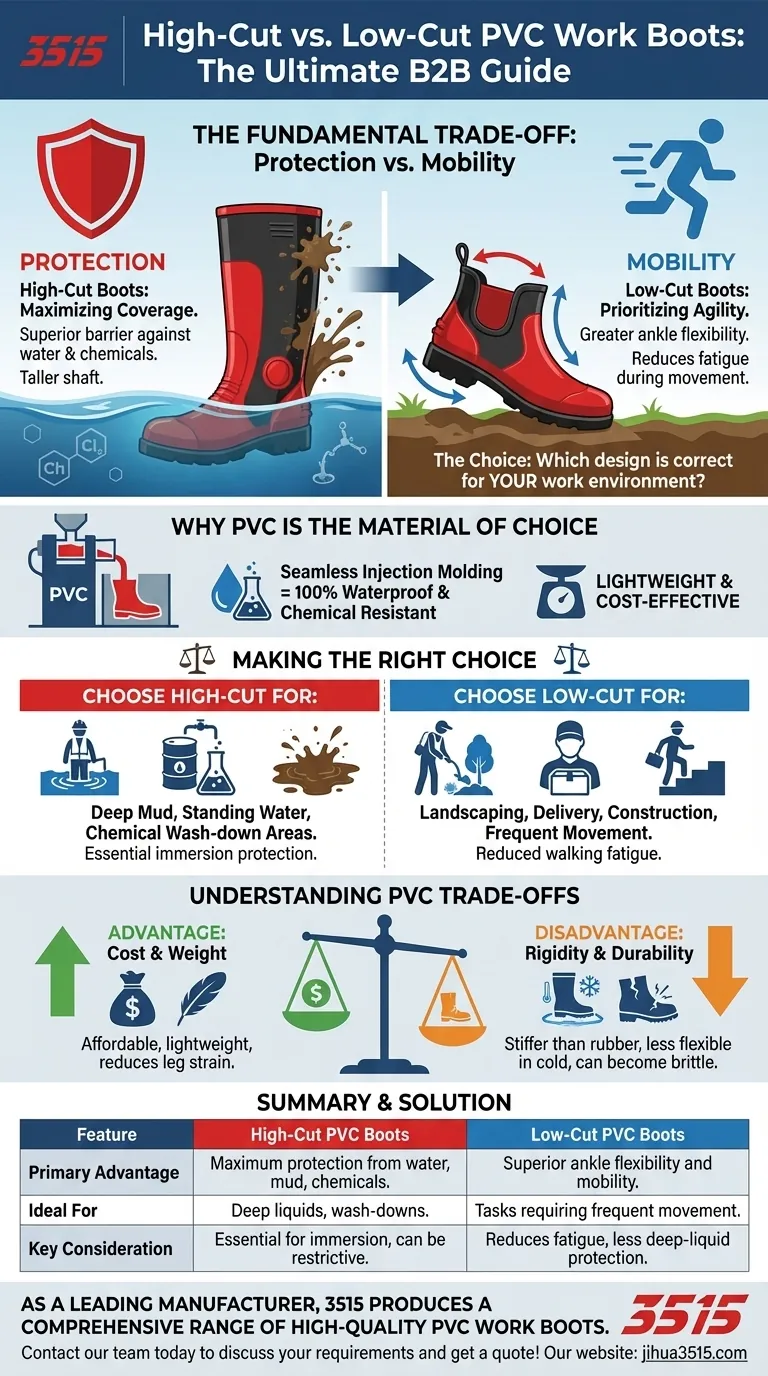The fundamental difference between high-cut and low-cut PVC work boots lies in a direct trade-off between environmental protection and user mobility. High-cut boots extend further up the leg to provide a superior barrier against water and chemicals. In contrast, low-cut boots offer greater ankle flexibility, making them more comfortable for tasks that require frequent movement.
The choice isn't about which boot is universally better, but which design is correct for your specific work environment. Your decision hinges on whether your daily tasks demand maximum protection from deep splashes or maximum agility for constant motion.

The Core Trade-off: Protection vs. Mobility
The design of a PVC boot directly dictates its ideal use case. The height of the boot shaft is the most critical factor in this decision.
High-Cut Boots: Maximizing Coverage
A high-cut design serves as a taller barrier. Its primary purpose is to protect your legs and feet from significant exposure to liquids.
This makes it the ideal choice for environments with standing water, deep mud, or potential for chemical splashes that could go over the top of a shorter boot.
Low-Cut Boots: Prioritizing Agility
A low-cut design ends closer to the ankle, which significantly increases your range of motion. This design reduces fatigue during extensive walking or climbing.
This enhanced flexibility is crucial for jobs that require frequent squatting, kneeling, or navigating uneven terrain, where a stiffer, high-cut boot would feel restrictive.
Why PVC is the Material of Choice
Unlike traditional rubber or leather, PVC boots are made via injection molding. This process creates a single, seamless unit.
This seamless construction is what makes PVC boots inherently 100% waterproof and highly resistant to many chemicals right out of the box, all while being lightweight and inexpensive.
Understanding the Trade-offs of PVC
While effective, PVC as a material has specific characteristics you must consider before making a final decision.
Advantage: Cost and Weight
PVC is a cost-effective material, making these boots an accessible option for many industries. They are also significantly lighter than many rubber alternatives.
This lightweight nature makes them suitable for jobs or activities that require being on your feet all day, as they reduce overall leg strain.
Disadvantage: Rigidity and Long-Term Durability
Generally, PVC is stiffer than rubber. This can lead to less comfort and flexibility, especially in colder temperatures.
Over time and with heavy use, PVC can also lose its original shape and become brittle. This means it may be less durable than a high-quality rubber boot in the long run.
Making the Right Choice for Your Task
Ultimately, your specific job requirements should guide your selection.
- If your primary focus is working in deep mud, water, or chemical wash-down areas: Choose high-cut boots for their essential splash and immersion protection.
- If your primary focus is mobility for tasks like landscaping, delivery, or construction: Opt for low-cut boots to gain ankle flexibility and reduce fatigue from walking.
- If your primary focus is long-term durability and flexibility in harsh conditions: You may want to weigh the benefits of a potentially more expensive rubber boot against the stiffness of PVC.
By matching the boot's design to your daily demands, you ensure optimal safety, comfort, and efficiency on the job.
Summary Table:
| Feature | High-Cut PVC Boots | Low-Cut PVC Boots |
|---|---|---|
| Primary Advantage | Maximum protection from water, mud, and chemical splashes | Superior ankle flexibility and mobility |
| Ideal For | Deep mud, standing water, chemical wash-down areas | Landscaping, delivery, construction, tasks requiring frequent movement |
| Key Consideration | Essential for immersion protection; can feel restrictive | Reduces fatigue from walking; less protection from deep liquids |
As a leading manufacturer, 3515 produces a comprehensive range of high-quality PVC work boots for distributors, brand owners, and bulk clients.
We understand that the right boot is critical for safety and productivity. Our production capabilities encompass all types of footwear, ensuring you get the perfect balance of protection, mobility, and durability for your specific needs.
Let us help you equip your workforce with the right footwear. Contact our team today to discuss your requirements and get a quote!
Visual Guide

Related Products
- Safety Footwear Wholesale Manufacturer for Custom OEM/ODM Production
- Wholesale Safety Footwear Manufacturer for Bulk & Custom OEM Orders
- Premium Flame-Retardant Waterproof Safety Boots and Shoes
- High Performance Fire-Retardant Waterproof Safety Boots
- Premium Grain Leather Safety Boots for Bulk Supply
People Also Ask
- What are OSHA approved shoes? Understanding the Correct Standards for Workplace Safety
- What are the differences between steel toe, composite toe, and alloy toe Wellington boots? Choose the Right Safety Toe for Your Job
- Is safety-toe as good as steel toe? Choose the Right Protection for Your Job
- What are the cultural perspectives on wearing shoes in the house? A Guide to Home Etiquette & Hygiene
- How do safety shoes contribute to cost savings for companies? A Strategic Investment in Risk and Cost Management



















